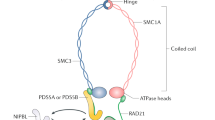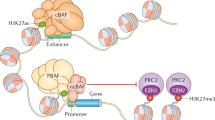Abstract
Here we report the discovery of truncating mutations of the gene encoding the cohesin subunit STAG2, which regulates sister chromatid cohesion and segregation, in 36% of papillary non-invasive urothelial carcinomas and 16% of invasive urothelial carcinomas of the bladder. Our studies suggest that STAG2 has a role in controlling chromosome number but not the proliferation of bladder cancer cells. These findings identify STAG2 as one of the most commonly mutated genes in bladder cancer.
This is a preview of subscription content, access via your institution
Access options
Subscribe to this journal
Receive 12 print issues and online access
$209.00 per year
only $17.42 per issue
Buy this article
- Purchase on Springer Link
- Instant access to full article PDF
Prices may be subject to local taxes which are calculated during checkout


Similar content being viewed by others
Accession codes
References
Solomon, D.A. et al. Science 333, 1039–1043 (2011).
Walter, M.J. et al. N. Engl. J. Med. 366, 1090–1098 (2012).
Cancer Genome Atlas Research Network. Nature 474, 609–615 (2011).
Howlader, N. et al. SEER Cancer Statistics Review, 1975–2009 (Vintage 2009 Populations), http://seer.cancer.gov/csr/1975_2009_pops09/, based on November 2011 SEER data submission.
Welch, J.S. et al. Cell 150, 264–278 (2012).
Michaelis, C., Ciosk, R. & Nasmyth, K. Cell 91, 35–45 (1997).
Rao, H. et al. Nature 410, 955–959 (2001).
Remeseiro, S. et al. EMBO J. 31, 2076–2089 (2012).
Miettinen, M. Appl. Immunohistochem. 20, 410–412 (2012).
Miettinen, M. et al. Am. J. Surg. Pathol. 36, 629–639 (2012).
Kim, J.H. et al. Lab. Invest. 85, 532–549 (2005).
Rink, M. et al. Urol. Oncol. doi:10.1016/j.urolonc.2012.06.011 (1 September 2012).
Solomon, D.A. et al. Cancer Res. 68, 10300–10306 (2008).
Acknowledgements
We thank B. Vogelstein for assistance in acquiring samples and preparing genomic DNA. This work was supported by US National Institutes of Health grants R01CA169345, R01CA159467 and R21CA143282 to T.W., by the MD Anderson Cancer Center Bladder Cancer SPORE grant P50CA091846 and by the Intramural Research Program of the National Human Genome Research Institute, US National Institutes of Health.
Author information
Authors and Affiliations
Contributions
D.A.S., J.-S.K., J.B., S.F.S., C.D.J., B.C., M.M. and T.W. designed research. D.A.S., J.-S.K., J.B., Z.-F.W., A.G.E., T.O., J.G., D.Z., S.Z. and J.J.P. performed research. J.B., S.F.S., D.Z., M.A.R., B.V., R.H., R.K., P.C.W.H., G.N., D.T., B.C. and M.M. contributed new reagents and analytic tools. D.A.S., J.-S.K., S.F.S., A.G.E., N.N., A.S.-R., B.D.R., C.D.J., M.M. and T.W. analyzed data. D.A.S., S.F.S. and T.W. wrote the manuscript.
Corresponding author
Ethics declarations
Competing interests
A provisional patent application has been filed by Georgetown University related to the technology described in this paper on which D.A.S., J.-S.K. and T.W. are the inventors.
Supplementary information
Supplementary Text and Figures
Supplementary Figures 1–21 and Supplementary Tables 1 and 4–6 (PDF 34619 kb)
Supplementary Table 2
Clinicopathologic characteristics of 111 urothelial carcinomas of the bladder used for STAG2 sequencing. (XLSX 20 kb)
Supplementary Table 3
STAG2 mutations identified in urothelial carcinoma primary tumors and cell lines. (XLSX 13 kb)
Rights and permissions
About this article
Cite this article
Solomon, D., Kim, JS., Bondaruk, J. et al. Frequent truncating mutations of STAG2 in bladder cancer. Nat Genet 45, 1428–1430 (2013). https://doi.org/10.1038/ng.2800
Received:
Accepted:
Published:
Issue Date:
DOI: https://doi.org/10.1038/ng.2800
This article is cited by
-
The synergism of SMC1A cohesin gene silencing and bevacizumab against colorectal cancer
Journal of Experimental & Clinical Cancer Research (2024)
-
Alterations of cohesin complex genes in acute myeloid leukemia: differential co-mutations, clinical presentation and impact on outcome
Blood Cancer Journal (2023)
-
The multifaceted roles of cohesin in cancer
Journal of Experimental & Clinical Cancer Research (2022)
-
Potential role of STAG1 mutations in genetic predisposition to childhood hematological malignancies
Blood Cancer Journal (2022)
-
Bladder carcinomas in patients with neurogenic bladder and urinary schistosomiasis: are they the same tumors?
World Journal of Urology (2022)



